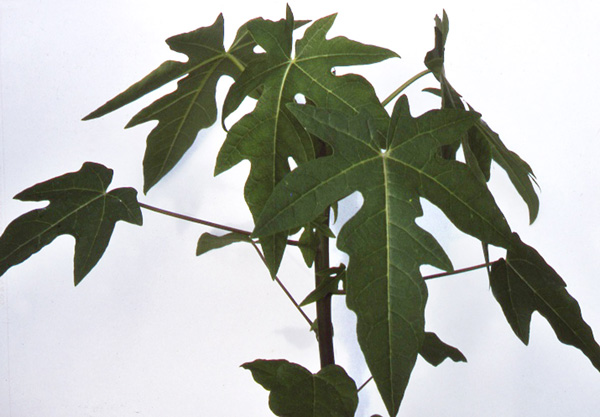You certainly need a heated greenhouse to crop this beauty, but not to grow it. The papaw plant is easy to grow, even on a sunny windowsill, well at first. You see this is one of the fastest growing of all, from seed to a veritable small tree the first year. It’s much better as an impressive foliage plant (the leaves are large, clean, dark coloured distinctly shaped somewhat like a figs) than for it’s flowers (somewhat resembling a melons) and the fruit is hard to ripen here in our dim UK.
If you’ve never tried a papaw / papaya it’s a tasty fruit sold in bigger supermarkets and greengrocers. Like a pear shaped melon, yellow skin and pink flesh with a wad of round hard inedible seeds conveniently packed in the middle. The flesh is eaten fresh usually with lime or lemon juice sometimes with sugar as well. Oddly this always tastes best the first time and never as good thereafter.
The sap from unripe fruit has been used to remove warts, and the leaves wrapped around meat overnight or cooked with it tenderises. I’ve boiled a tough old bird after marinating with the leaves and the flesh (though not much in total) just fell off the bones. Carica papaya is a tropical plant, and as I said, good for an impressive foliage plant, and quickly.
If you buy fresh fruit now and sow some of the gunshot like seeds somewhere warm they soon come up. Any reasonable potting compost will do, keep it moist never wet and give the seedlings warmth and the full sun they crave. Pot on soon and often for these are going to rocket, by early summer the plants can be head height. Now you can put some of these out as bedding plants for height and dramatic effect if you harden them off first. However they’re happier under cover in the warm where they may go on to flower.

Now originally these were dioecious with males flowering on slender branches atop some plants and the females flowering up along the trunks of others.
Intensive breeding has produced commercial varieties with both types of flower on each plant and so although their offspring don’t come true from seed if you sow several you’ll probably get some of each type. But to be fair your chances of producing a crop of ripe fruits is slim as these are very hard plants to get through winter, even if with a well heated greenhouse.
Like so many tender plants it’s not the cold as such that usually kills them but our low winter light. Unlike shrubby plants these are invariably hollow unbranched single trunks hard to prune or strike as cuttings. And not being very woody subjects they cannot go even partly dormant, in low light they just stop flourishing, then very soon after mould finishes them off. Now it can be done; so there’s a challenge for you.
Intensive breeding has produced commercial varieties with both types of flower on each plant and so although their offspring don’t come true from seed if you sow several you’ll probably get some of each type. But to be fair your chances of producing a crop of ripe fruits is slim as these are very hard plants to get through winter, even if with a well heated greenhouse. Like so many tender plants it’s not the cold as such that usually kills them but our low winter light. Unlike shrubby plants these are invariably hollow unbranched single trunks hard to prune or strike as cuttings. And not being very woody subjects they cannot go even partly dormant, in low light they just stop flourishing, then very soon after mould finishes them off. Now it can be done; so there’s a challenge for you.


